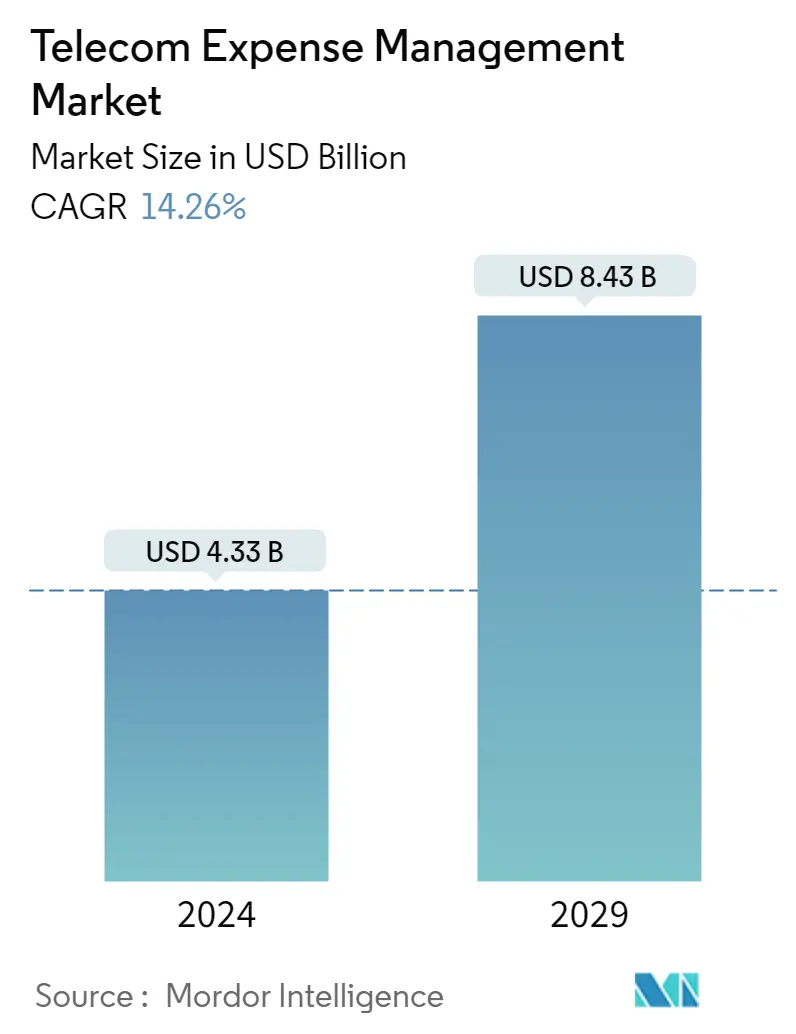Market Size of Telecom Expense Management Industry

| Study Period | 2019 - 2029 |
| Market Size (2024) | USD 4.33 Billion |
| Market Size (2029) | USD 8.43 Billion |
| CAGR (2024 - 2029) | 14.26 % |
| Fastest Growing Market | Asia Pacific |
| Largest Market | North America |
| Market Concentration | Medium |
Major Players
*Disclaimer: Major Players sorted in no particular order |
Telecom Expense Management Market Analysis
The Telecom Expense Management Market size is estimated at USD 4.33 billion in 2024, and is expected to reach USD 8.43 billion by 2029, growing at a CAGR of 14.26% during the forecast period (2024-2029).
Telecom Expense Management has become an essential practice for enterprises operating across any business domain/industry, irrespective of their size. The increased requirement for efficient telecom expense management practices is one of the transforming trends in the market, coupled with the expansion that has been observed in the business telecom infrastructures in the past few years.
- The increasing demand for mobile applications, the growing adoption of portable equipment in multiple enterprises, and the technological advancements in telecom expense management solutions are driving the growth of the telecom expense management market. Furthermore, increased adoption of mobile devices, visibility into expense management, and the growing popularity of cloud-based services are also aiding market growth.
- The ongoing trend of integrating individual mobile devices, such as smartphones, laptops, and tablets, under mobility policies such as the choose-your-own-device (CYD), and bring-your-own-devices for one, has been transforming the market over the past few years. Also, the augmented integration of mobile devices in the inner telecom networks has highlighted the requirement for a holistic system for managing and monitoring costs and using telecom resources.
- Further, due to the growing startup culture across developed and developing economies, the increasing number of small and medium-sized enterprises has led companies willing to adopt the BYOD culture to eliminate or restrict the initial infrastructure expenses, which may limit their early growth. Such trends are expected to create several opportunities for telecom expense management solutions.
- The ease of adoption of cloud-based technologies has boosted the adoption of video conferencing among businesses, driving the adoption of cloud services for various business needs. These are overwhelming the current networks and increasing the requirement for advanced network solutions, proliferating enterprises to invest in telecom expense management solutions.
- Thus, globally, telecom operators align themselves in the cloud value chain by managing cloud connectivity and leveraging network assets to enhance and optimize cloud-based solutions and services. Moreover, the growing need for easily maintained network systems that can enable effective communications across multiple end-user industries, including healthcare, retail, and manufacturing, is evident. For instance, the advent of cost-effective cloud-based solutions has seen increased adoption by healthcare providers, which are often categorized as having minimum IT budgets.
- With the outbreak of COVID-19, the telecom industry witnessed a significant increase in demand for internet services due to a major chunk of the population staying at home due to remote working conditions. The increase in people working from home led to an increase in demand for downloading, online video viewing, and communication through video conferencing, all of which are leading to increased network traffic and data usage.
Telecom Expense Management Industry Segmentation
Telecom expense management primarily refers to a service that is being adopted by various types of enterprises for optimizing their telecom cost, handling inventory management, bill payment, procurement and invoice management, and other functions carried on a single platform. There has been increased incorporation of telecom-related services by organizations to bolster communication across various business units, partners, and clients located at different geographic locations.
Telecom expense management market is segmented by solution (invoice management, sourcing management, business management, dispute management), service (hosted service, managed service), end-user industry (BFSI, consumer goods and retail, manufacturing, IT and telecom, healthcare) and geography (North America, Europe, Asia Pacific, Latin America, and Middle East and Africa).The market sizes and forecasts are provided in value (USD) for all the above segments.
| By Solution | |
| Invoice Management | |
| Sourcing Management | |
| Business Management | |
| Dispute Management | |
| Other Solutions |
| By Service | |
| Hosted Service | |
| Managed Service |
| By End-user Industry | |
| BFSI | |
| Consumer Goods & Retail | |
| Manufacturing | |
| IT & Telecom | |
| Healthcare | |
| Other End-user Industries |
| By Geography | |
| North America | |
| Europe | |
| Asia-Pacific | |
| Latin America | |
| Middle East & Africa |
Telecom Expense Management Market Size Summary
The telecom expense management market is experiencing significant growth, driven by the increasing need for efficient management of telecom costs across various industries. As businesses expand their telecom infrastructures and adopt mobile and cloud-based solutions, the demand for comprehensive expense management systems has surged. This trend is further fueled by the integration of mobile devices under policies like BYOD and CYOD, which necessitate robust systems to monitor and control telecom expenses. The market is also benefiting from the rise of small and medium-sized enterprises, particularly in regions like Latin America, where the adoption of advanced technologies and the shift towards 5G networks are creating new opportunities for telecom expense management solutions.
Key players in the market are actively pursuing strategic collaborations and product innovations to strengthen their positions and expand their reach. The semi-consolidated nature of the market is evident as companies like Calero-MDSL and Tangoe continue to enhance their offerings through acquisitions and technological advancements. The COVID-19 pandemic has further accelerated the demand for telecom expense management solutions, as remote working conditions have led to increased network traffic and data usage. As businesses increasingly rely on cloud-based services and advanced network solutions, the telecom expense management market is poised for continued growth, with significant opportunities in sectors such as healthcare, retail, and manufacturing.
Telecom Expense Management Market Size - Table of Contents
-
1. MARKET INSIGHTS
-
1.1 Market Overview
-
1.2 Industry Value Chain Analysis
-
1.3 Industry Attractiveness - Porters Five Forces Analysis
-
1.3.1 Bargaining Power of Suppliers
-
1.3.2 Bargaining Power of Buyers/Consumers
-
1.3.3 Threat of New Entrants
-
1.3.4 Threat of Substitute Products
-
1.3.5 Intensity of Competitive Rivalry
-
-
1.4 Assessment of Impact of COVID-19 on the Market
-
-
2. MARKET SEGMENTATION
-
2.1 By Solution
-
2.1.1 Invoice Management
-
2.1.2 Sourcing Management
-
2.1.3 Business Management
-
2.1.4 Dispute Management
-
2.1.5 Other Solutions
-
-
2.2 By Service
-
2.2.1 Hosted Service
-
2.2.2 Managed Service
-
-
2.3 By End-user Industry
-
2.3.1 BFSI
-
2.3.2 Consumer Goods & Retail
-
2.3.3 Manufacturing
-
2.3.4 IT & Telecom
-
2.3.5 Healthcare
-
2.3.6 Other End-user Industries
-
-
2.4 By Geography
-
2.4.1 North America
-
2.4.2 Europe
-
2.4.3 Asia-Pacific
-
2.4.4 Latin America
-
2.4.5 Middle East & Africa
-
-
Telecom Expense Management Market Size FAQs
How big is the Telecom Expense Management Market?
The Telecom Expense Management Market size is expected to reach USD 4.33 billion in 2024 and grow at a CAGR of 14.26% to reach USD 8.43 billion by 2029.
What is the current Telecom Expense Management Market size?
In 2024, the Telecom Expense Management Market size is expected to reach USD 4.33 billion.

